初二英语公开课全国一等奖
- 格式:pdf
- 大小:718.14 KB
- 文档页数:10
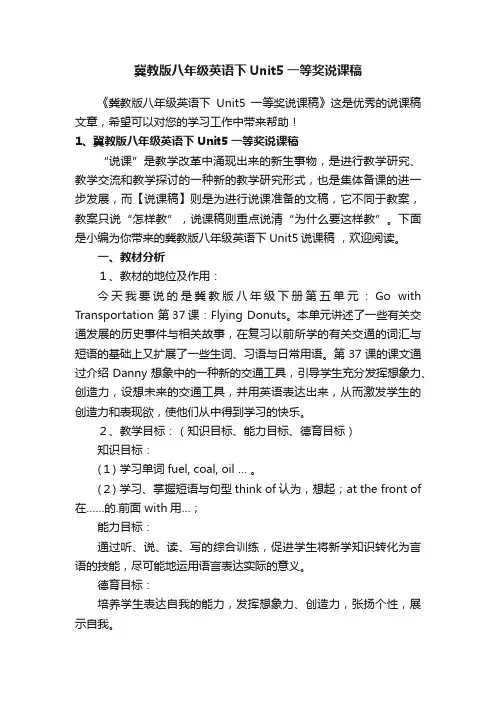
冀教版八年级英语下Unit5一等奖说课稿《冀教版八年级英语下Unit5一等奖说课稿》这是优秀的说课稿文章,希望可以对您的学习工作中带来帮助!1、冀教版八年级英语下Unit5一等奖说课稿“说课”是教学改革中涌现出来的新生事物,是进行教学研究、教学交流和教学探讨的一种新的教学研究形式,也是集体备课的进一步发展,而【说课稿】则是为进行说课准备的文稿,它不同于教案,教案只说“怎样教”,说课稿则重点说清“为什么要这样教”。
下面是小编为你带来的冀教版八年级英语下Unit5说课稿,欢迎阅读。
一、教材分析1、教材的地位及作用:今天我要说的是冀教版八年级下册第五单元:Go with Transportation 第37课:Flying Donuts。
本单元讲述了一些有关交通发展的历史事件与相关故事,在复习以前所学的有关交通的词汇与短语的基础上又扩展了一些生词、习语与日常用语。
第37课的课文通过介绍Danny想象中的一种新的交通工具,引导学生充分发挥想象力、创造力,设想未来的交通工具,并用英语表达出来,从而激发学生的创造力和表现欲,使他们从中得到学习的快乐。
2、教学目标:(知识目标、能力目标、德育目标)知识目标:(1) 学习单词fuel, coal, oil … 。
(2) 学习、掌握短语与句型think of认为,想起;at the front of 在……的.前面 with用…;能力目标:通过听、说、读、写的综合训练,促进学生将新学知识转化为言语的技能,尽可能地运用语言表达实际的意义。
德育目标:培养学生表达自我的能力,发挥想象力、创造力,张扬个性,展示自我。
确立教学目标的依据:根据英语教学大纲规定,通过听、说、读、写的训练,使学生获得英语基础知识与为交际初步运用英语的能力,激发学生的学习兴趣,为进一步学习打好初步的基础。
此外,根据我国国情与外语教学大纲的要求,现阶段外语教学的素质教育主要包括思想素质教育、目的语素质教育、潜在外语能力的培养、非智力因素的培养等四方面。

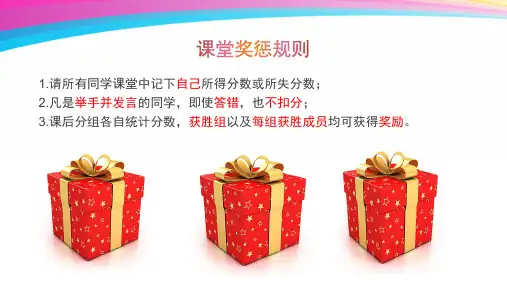
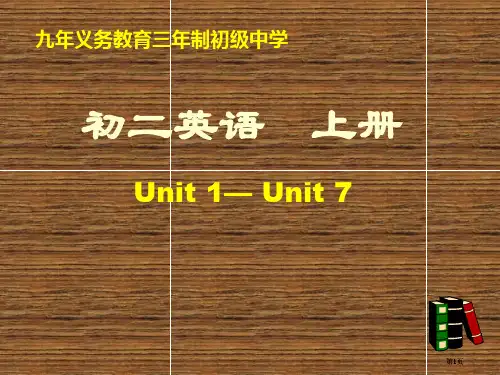
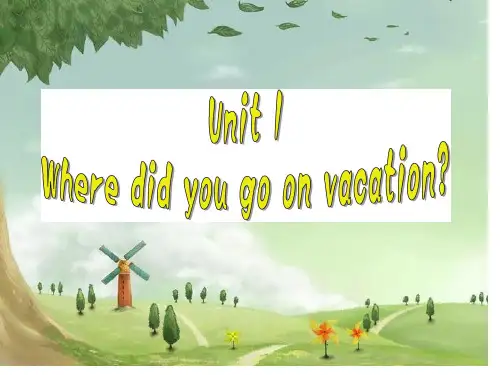
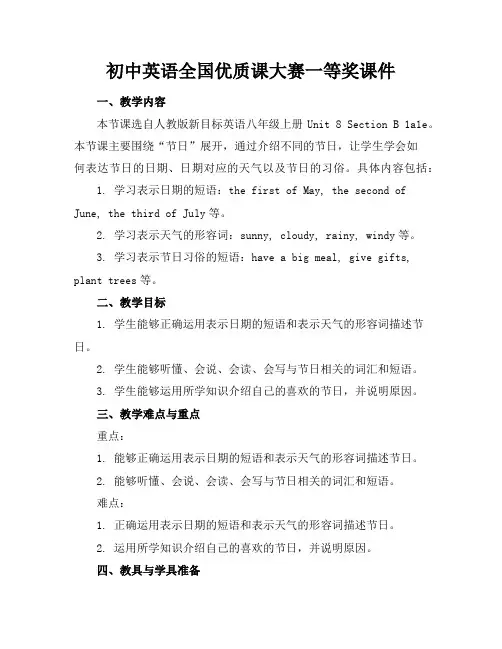
初中英语全国优质课大赛一等奖课件一、教学内容本节课选自人教版新目标英语八年级上册Unit 8 Section B 1a1e。
本节课主要围绕“节日”展开,通过介绍不同的节日,让学生学会如何表达节日的日期、日期对应的天气以及节日的习俗。
具体内容包括:1. 学习表示日期的短语:the first of May, the second of June, the third of July等。
2. 学习表示天气的形容词:sunny, cloudy, rainy, windy等。
3. 学习表示节日习俗的短语:have a big meal, give gifts, plant trees等。
二、教学目标1. 学生能够正确运用表示日期的短语和表示天气的形容词描述节日。
2. 学生能够听懂、会说、会读、会写与节日相关的词汇和短语。
3. 学生能够运用所学知识介绍自己的喜欢的节日,并说明原因。
三、教学难点与重点重点:1. 能够正确运用表示日期的短语和表示天气的形容词描述节日。
2. 能够听懂、会说、会读、会写与节日相关的词汇和短语。
难点:1. 正确运用表示日期的短语和表示天气的形容词描述节日。
2. 运用所学知识介绍自己的喜欢的节日,并说明原因。
四、教具与学具准备1. 教具:多媒体课件、黑板、粉笔2. 学具:教材、笔记本、文具五、教学过程1. 情景引入(5分钟)2. 展示课件(15分钟)教师播放课件,展示不同节日的图片,引导学生说出对应的节日名称,并板书。
接着,教师引导学生用表示日期的短语和表示天气的形容词描述这些节日,如:“the first of May, sunny”。
3. 小组讨论(10分钟)学生分小组,讨论自己喜欢的节日,并用所学词汇和短语进行描述。
讨论结束后,每组选代表进行分享。
4. 随堂练习(10分钟)教师给出练习题,学生独立完成,检测所学知识。
练习题包括选择题、填空题和问答题。
5. 课堂小结(5分钟)六、板书设计板书内容主要包括本节课的主要节日、表示日期的短语、表示天气的形容词以及相关习俗的短语。
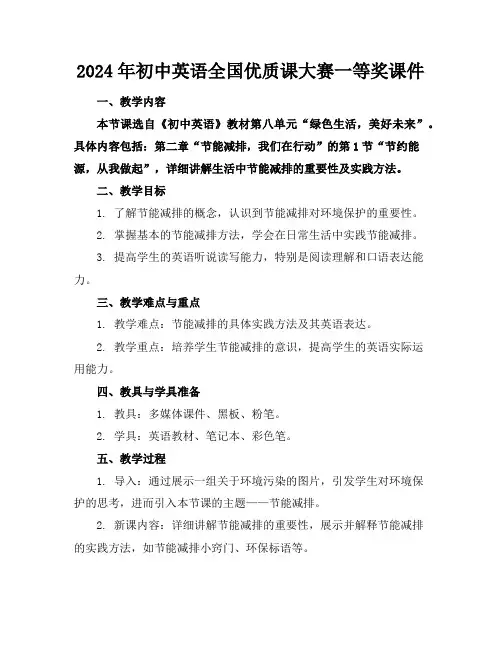
2024年初中英语全国优质课大赛一等奖课件一、教学内容本节课选自《初中英语》教材第八单元“绿色生活,美好未来”。
具体内容包括:第二章“节能减排,我们在行动”的第1节“节约能源,从我做起”,详细讲解生活中节能减排的重要性及实践方法。
二、教学目标1. 了解节能减排的概念,认识到节能减排对环境保护的重要性。
2. 掌握基本的节能减排方法,学会在日常生活中实践节能减排。
3. 提高学生的英语听说读写能力,特别是阅读理解和口语表达能力。
三、教学难点与重点1. 教学难点:节能减排的具体实践方法及其英语表达。
2. 教学重点:培养学生节能减排的意识,提高学生的英语实际运用能力。
四、教具与学具准备1. 教具:多媒体课件、黑板、粉笔。
2. 学具:英语教材、笔记本、彩色笔。
五、教学过程1. 导入:通过展示一组关于环境污染的图片,引发学生对环境保护的思考,进而引入本节课的主题——节能减排。
2. 新课内容:详细讲解节能减排的重要性,展示并解释节能减排的实践方法,如节能减排小窍门、环保标语等。
3. 例题讲解:挑选教材中的典型例题,讲解解题思路,引导学生掌握解题方法。
4. 随堂练习:布置教材中的练习题,让学生及时巩固所学知识。
5. 小组讨论:分组讨论生活中节能减排的实例,提高学生的口语表达和合作能力。
六、板书设计1. 绿色生活,美好未来2. 内容:节能减排的定义节能减排的重要性节能减排的实践方法相关英语表达七、作业设计1. 作业题目:(1)列举生活中的节能减排实例,用英语进行描述。
(2)以“节能减排,从我做起”为主题,写一篇英语短文,不少于80词。
答案:(1)例如:Turn off the lights when leaving the room.(离开房间时关灯)节能减排,从我做起As we all know, energy saving and emission reduction are of great importance to environmental protection. We shouldtake practical actions to save energy and reduce emissions in our daily lives.Firstly, we can turn off the lights when leaving the room to save electricity. Secondly, we can choose public transportation or ride bicycles instead of driving private cars, which can help reduce air pollution. Moreover, weshould use watersaving devices and avoid wasting water. Finally, it's a good habit to sort waste and recycle useful materials.Let's work together to protect our environment and builda better future.八、课后反思及拓展延伸1. 课后反思:本节课通过实际案例和互动讨论,使学生认识到节能减排的重要性,提高了学生的环保意识和英语实际运用能力。
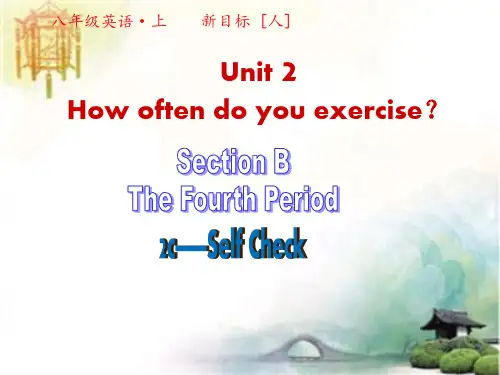
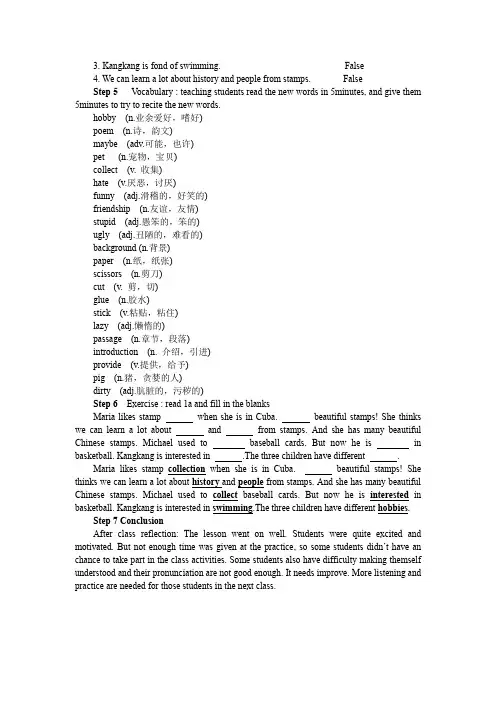
初中英语教学案例一等奖(1)教学主题Unit 3 Our Hobbies Project English (仁爱八年级英语)Topic 1 What’s your hobby ? Section B教学对象Junior high school 8 grades教学功能Expressing students’ likes and dislikesLanguage pointsbe interested in 对……感兴趣used to do sth 过去常常做某事教学词汇Words to describe hobbiesTeaching strategies1. Collecting expressions2. Paying attention to students’ pronunciation教学课时 1Teaching procedureStep 1Warming up: using 10 minutes ask students about the hobbies,then let two or three groups make short dialogues. Students need to use the structuresStep 2First, using 5 minutes ask three students to make up the group,and read Section B 1a. then, using another 5 minutes listen to 1a.Michael : Hi,Maria!What are you carrying?Maria : It’s my stamp collection.Would you like to see it?Michael : Wow! What beautiful stamps!Are they all from China?Maria : Not all.I collected some of them from Cuba.But now I also have a lot of beautiful stamps from China.Michael : It must be fun.Maria : It certainly is.We can learn a lot about history and people from stamps.What hobbies did you used to have?Michael : I used to collect baseball cards.But now I’m interested in basketball.Kangkang: Hi,Maria! Hi,Michael!What are you looking at?Michael : Hi, Kangkang! We are looking at Maria’s stamps collection.Where are you going?Kangkang: I’m going swimming.It’s my favorite hobby.Step 3Show the target language:1. What’s you hobbies?2. I used to like/love/enjoy.....but now I hate it/don’t like/enjoy/love it.3. I am fond of/interested in......Step 4Listening :listen to 1a and circle true or false1. Maria only collects Chinese stamps. True2. Michael’s favorite hobby is playing baseball. False3. Kangkang is fond of swimming. False4. We can learn a lot about history and people from stamps. FalseStep 5V ocabulary : teaching students read the new words in 5minutes, and give them 5minutes to try to recite the new words.hobby (n.业余爱好,嗜好)poem (n.诗,韵文)maybe (adv.可能,也许)pet (n.宠物,宝贝)collect (v. 收集)hate (v.厌恶,讨厌)funny (adj.滑稽的,好笑的)friendship (n.友谊,友情)stupid (adj.愚笨的,笨的)ugly (adj.丑陋的,难看的)background (n.背景)paper (n.纸,纸张)scissors (n.剪刀)cut (v. 剪,切)glue (n.胶水)stick (v.粘贴,粘住)lazy (adj.懒惰的)passage (n.章节,段落)introduction (n. 介绍,引进)provide (v.提供,给予)pig (n.猪,贪婪的人)dirty (adj.肮脏的,污秽的)Step 6Exercise : read 1a and fill in the blanksMaria likes stamp when she is in Cuba. beautiful stamps! She thinks we can learn a lot about and from stamps. And she has many beautiful Chinese stamps. Michael used to baseball cards. But now he is in basketball. Kangkang is interested in .The three children have different .Maria likes stamp collection when she is in Cuba. beautiful stamps! She thinks we can learn a lot about history and people from stamps. And she has many beautiful Chinese stamps. Michael used to collect baseball cards. But now he is interested in basketball. Kangkang is interested in swimming.The three children have different hobbies.Step 7 ConclusionAfter class reflection: The lesson went on well. Students were quite excited and motivated. But not enough time was given at the practice, so some students didn’t have an chance to take part in the class activities. Some students also have difficulty making themself understood and their pronunciation are not good enough. It needs improve. More listening and practice are needed for those students in the next class.初中英语教学案例一等奖(2)Part One —— Analysis of the Teaching MaterialOne: Status and Function1. This unit tells us the improvement of traffic transportation and the related stories. Besides learning this, students will also learn some words, phrases and expressions of traffic, and so on. In Lesson 37, Danny will introduce a new type of transportation to us, it is imaginary.2. To attain “four skills” request of listening, speaking, reading and writing, I will have the students do some exercise about the text.3. Such a topic is very important in this unit. I will lead the students to use their imagination and encourage them to be creative. For example, helping them use English to describe their imaginary transportation. So I think if the students can learn this lesson well, it will be helpful to make them learn the rest of this unit.4. While teaching them, I will also encourage them to say something about what they think the future transportation will be like. In a way, from practising such a topic, it can be helpful to raise learning interests of students and it will be also helpful to improve their spoken language.Two: Teaching Aims and DemandsThe teaching aim’s basis is established according to Junior School English syllabus’ provision.1. To study the new words “fuel”, “oil” and “coal”.2. To learn and master the phrases “think of, on the way to …, have fun”, etc.3. To develop the students’ abilities of listening, speaking, reading and writing.4. To train the students’ ability of working in pairs.5. To develop the students’ abilities of communication by learning the useful structures.Three: Teaching Keys and Difficult PointsThe teaching keys and difficult points’ basis is established according to Lesson 37 in the teaching material's position and function.1. Key points:(1) Be able to express words, phrases and sentences in English.(2) Know about the improvement of transportation and Danny’s invention.2. Difficult points:Be able to talk about their imaginary future transportation in oral English.Part Two —— The Teaching Methods1. Communicative teaching method;2. Audio-visual teaching method;3. Task-based teaching method;4. Classified teaching method.As we all know: the main instructional aims of learning English in the Middle School is to cultivate students’ abilities of listening, speaking, reading, writing and their good sense of the English language. So in this lesson I’ll mainly use “Communicative” teaching method, “Audio-visual” teaching method and “Task-based” teaching method and “Classified” teaching method. That is to say, I’ll let the students get a better understanding of the key structures. I’llgive the students some tasks and arrange some kinds of activities, like talking, watching CAI, and reading in roles.In a word, I want to make the students the real masters in class while the teacher himself acts as director. I also hope to combine the language structures with the language functions and let the students receive some moral education while they are learning the English language.Part Three —— Studying ways1. Teach the students how to be successful language learners.2. Make situation and provide meaningful duty, encourage the students to study the text by themselves.Part Four —— Teaching stepsAs this lesson plays an important part in the English teaching of this unit, I have decided the following steps to train their ability of listening, speaking, reading and writing, especially reading and speaking ability.The entire steps are:Step 1 Warm-up and Lead-inShow the students some pictures of common transportation, like car, bike, train and so on. Ask the students: What can you see from the picture? Is there another kind of transportation around us?Purpose of my designing: In this part, have the students say more about what they see or what they don’t see. In this way, they will know today’s lesson has something to do with their discussion.Step 2 Presentation1. Learn new words in groups. The new word in this lesson are fuel, oil and coal. Show them pictures of these things and teach them these new words.Purpose of my designing: After seeing the pictures, the students will know what they are and they can learn them quickly and easily.2. Play the tape recorder. Let the students listen and imitate the text. Pay attention to their pronunciation and intonation. Then finish the exercises.Purpose of my designing: This step is employed to make the students get the general idea of the text. At the same time let the students have a chance to practise their listening and speaking ability.3. Text Learning and a QuizI’ll use CAI to present the whole text. I’ll write the key points on the blackboard while they are watching. After watching, I’ll teach them to read the words and sentences on the Bb. Make sure they can read them well.After teaching them the whole text, including the meanings of new words, the use of similar expressions and so on. Get the students to try and say out some phrases on the screen, like I don’t think so, have fun, a new kind of, on the way to school, and so on.Purpose of my designing: To present the text by CAI is much easier for the students to learn and grasp the meanings. CAI can provide a real situation with its sound and picture and it makes the relationships between the students better.4. Key Structures and Difficult Points LearningFirst, I will divide the students into three groups and tell them to have a discussion aboutwhat they learn in this lesson. Then encourage them to try to understand the whole text, know what the difficult points are, and so on. At last, I will help them to master them all.For example, I teach the students know the differences between phrases think of, think about and think over. I will show them some sentences and get them to know the use of these phrases. Encourage them to do some exercise about these phrases.Purpose of my designing: By practising using these new words and similar phrases, the students will know how to use them in English and master the use of them better.5. Read and SayGive the students two or three minutes to prepare, and then get them read the text together in three groups. Tell them to read aloud.Then help the students say something about the future transportation or their imaginary transportation. Encourage them to say more.Purpose of my designing: By reading the text and saying such things, get the students to practise their reading and speaking ability again.Part Five —— Summarize and HomeworkAsk the students such questions:What have we learned from this lesson? What does Danny say about his new kind / type of transportation? Do you like his idea? What new phrases have we learned today? Do you have enough confidence to finish these exercises? Now, let’s try!Then show them some exercises and help them to finish them.At last, tell the students what today’s homework is. While doing this, the teacher can have the boys and girls have a competition to see who are better.Part Six —— Blackboard DesigningLesson 37 Flying DonutsLanguage points:1.think of认为,想起think over仔细考虑think out想出2.at/in the front of在……前面(部)/ in front of在……前面3.on the way to school在上学的路上/ on one’s way home在回家路上4. With用……。
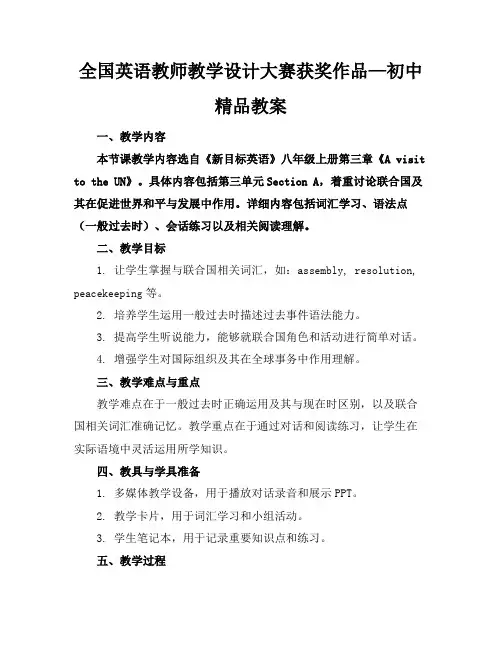
全国英语教师教学设计大赛获奖作品—初中精品教案一、教学内容本节课教学内容选自《新目标英语》八年级上册第三章《A visit to the UN》。
具体内容包括第三单元Section A,着重讨论联合国及其在促进世界和平与发展中作用。
详细内容包括词汇学习、语法点(一般过去时)、会话练习以及相关阅读理解。
二、教学目标1. 让学生掌握与联合国相关词汇,如:assembly, resolution, peacekeeping等。
2. 培养学生运用一般过去时描述过去事件语法能力。
3. 提高学生听说能力,能够就联合国角色和活动进行简单对话。
4. 增强学生对国际组织及其在全球事务中作用理解。
三、教学难点与重点教学难点在于一般过去时正确运用及其与现在时区别,以及联合国相关词汇准确记忆。
教学重点在于通过对话和阅读练习,让学生在实际语境中灵活运用所学知识。
四、教具与学具准备1. 多媒体教学设备,用于播放对话录音和展示PPT。
2. 教学卡片,用于词汇学习和小组活动。
3. 学生笔记本,用于记录重要知识点和练习。
五、教学过程1. 导入新课:通过展示联合国图片,引发学生思考其在国际事务中作用,自然引入新课。
小组讨论:让学生探讨联合国标志意义。
录音播放:听一段关于联合国工作对话,让学生预测对话内容。
2. 新知呈现:词汇教学:通过PPT展示和教学卡片,讲解并让学生练习新词汇。
语法讲解:以对话为例,讲解一般过去时用法。
3. 例题讲解:展示例题,解释一般过去时构造和应用。
让学生模仿例题,进行句子构造练习。
4. 随堂练习:分组对话练习:学生模拟联合国会议,进行角色扮演。
个人阅读理解:完成关于联合国阅读理解练习。
5. 巩固拓展:对话复述:学生复述所听对话,巩固词汇和语法。
角色扮演:学生模拟联合国代表,讨论国际问题。
六、板书设计板书将包括:1. 新词汇及其翻译。
2. 一般过去时构造和示例句子。
3. 联合国主要职能和活动。
七、作业设计1. 作业题目:编写一段关于联合国某次重要活动报道,至少包含5个新学词汇和一般过去时正确使用。
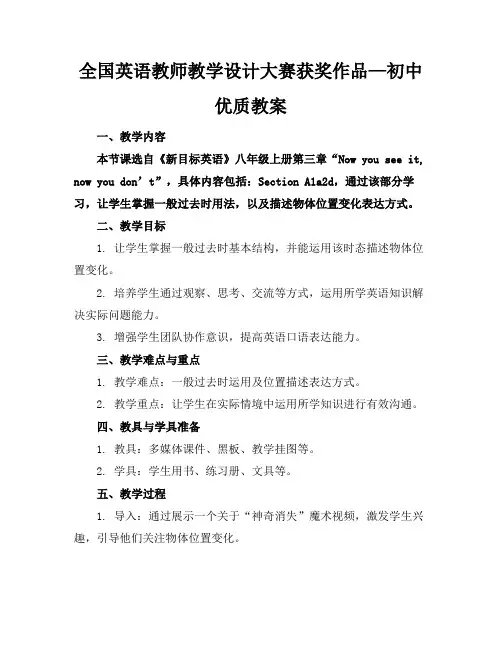
全国英语教师教学设计大赛获奖作品—初中优质教案一、教学内容本节课选自《新目标英语》八年级上册第三章“Now you see it, now you don’t”,具体内容包括:Section A1a2d,通过该部分学习,让学生掌握一般过去时用法,以及描述物体位置变化表达方式。
二、教学目标1. 让学生掌握一般过去时基本结构,并能运用该时态描述物体位置变化。
2. 培养学生通过观察、思考、交流等方式,运用所学英语知识解决实际问题能力。
3. 增强学生团队协作意识,提高英语口语表达能力。
三、教学难点与重点1. 教学难点:一般过去时运用及位置描述表达方式。
2. 教学重点:让学生在实际情境中运用所学知识进行有效沟通。
四、教具与学具准备1. 教具:多媒体课件、黑板、教学挂图等。
2. 学具:学生用书、练习册、文具等。
五、教学过程1. 导入:通过展示一个关于“神奇消失”魔术视频,激发学生兴趣,引导他们关注物体位置变化。
2. 呈现:呈现本节课主题,讲解一般过去时用法,让学生通过观察、思考、交流等方式,学会描述物体位置变化。
3. 讲解:结合教材内容,详细讲解一般过去时结构,以及位置描述表达方式。
4. 实践:设计小组活动,让学生用一般过去时描述物体位置变化,提高他们实际运用能力。
5. 巩固:进行随堂练习,检查学生对知识掌握情况,并及时进行反馈。
6. 作业布置:布置相关课后作业,巩固所学知识。
六、板书设计1. 板书主题:Now you see it, now you don’t!2. 内容:一般过去时结构:主语+动词过去式+其他描述物体位置变化表达方式:It was in/on/under七、作业设计1. 作业题目:(1)用一般过去时描述下列物体位置变化:a. The book was on the table, but now it’s on the chair.b. The keys were in the drawer, but now they are on the desk.(2)编写一段对话,描述你和你朋友在公园里玩捉迷藏游戏,运用一般过去时描述你们位置变化。
2024年初中英语全国优质课大赛一等奖课件一、教学内容本节课选自《初中英语》第七册,具体内容包括第四章“环境保护”的第一至第三小节。
详细内容涉及环保基本概念、全球环境问题及个人环保行动。
二、教学目标1. 了解和掌握环保的基本概念,认识到环境保护的重要性。
2. 学会描述全球环境问题,并能够提出相应的解决措施。
3. 培养学生环保意识,激发他们参与环保行动的热情。
三、教学难点与重点教学难点:环保概念的阐述、全球环境问题的描述及解决措施的表达。
教学重点:环保意识的培养、环保行动的实践。
四、教具与学具准备1. 教具:PPT、环保宣传视频、地球仪、海报。
2. 学具:笔记本、彩色笔、剪刀、胶水。
五、教学过程1. 实践情景引入(5分钟)播放环保宣传视频,引导学生关注环境问题。
分组讨论:我们身边存在哪些环境问题?如何解决这些问题?2. 例题讲解(10分钟)通过地球仪展示全球环境问题,引导学生学习环保概念。
讲解环保相关的词汇和句型,如:pollution, energy saving, carbon footprint等。
3. 随堂练习(15分钟)小组活动:制作环保海报,展示环保行动。
个人发言:每位学生介绍自己的环保措施。
4. 课堂小结(5分钟)学生分享学习收获和感悟。
六、板书设计1. 环保概念:污染、资源浪费、碳足迹等。
2. 全球环境问题:气候变暖、水资源短缺、物种灭绝等。
3. 环保行动:节能减排、垃圾分类、植树造林等。
七、作业设计1. 作业题目:以“我的环保行动”为主题,写一篇英语短文。
答案示例:八、课后反思及拓展延伸1. 反思:本节课的教学效果,学生的参与程度,以及教学过程中的不足。
2. 拓展延伸:组织学生参加环保活动,如社区清洁、植树等,将环保理念付诸实践。
同时,鼓励学生关注国内外环保动态,提高他们的环保意识。
重点和难点解析1. 教学内容的选取与组织2. 教学目标的设定3. 教学难点与重点的区分4. 教学过程的实践情景引入5. 作业设计的生活化与实际应用6. 课后反思及拓展延伸的深度与广度一、教学内容的选取与组织教学内容应紧扣环保主题,涵盖基本概念、全球环境问题及个人环保行动。
2024年初中英语全国优质课大赛一等奖课件一、教学内容本节课选自《初中英语》第七册,第十一章“环境保护”。
具体内容包括:第一节“环境保护的意义”,第二节“我们的地球”,第三节“气候变化与人类活动”,第四节“绿色生活,从我做起”。
详细内容涉及环境保护的定义、重要性,地球面临的环境问题,以及如何在生活中实践环保。
二、教学目标1. 知识与技能:使学生掌握环境保护的基本概念,了解地球面临的环境问题,提高学生的环保意识。
2. 过程与方法:通过小组讨论、实践活动,培养学生的合作能力、探究能力和解决问题的能力。
3. 情感态度与价值观:激发学生关爱环境、保护地球的责任感,使学生形成绿色生活的观念。
三、教学难点与重点教学难点:环境保护的意义,气候变化与人类活动的关系。
教学重点:环保的定义,地球面临的环境问题,绿色生活的实践方法。
四、教具与学具准备教具:多媒体课件、黑板、粉笔。
五、教学过程1. 导入:通过播放一段关于环境保护的短片,引导学生关注环保问题,激发学生的学习兴趣。
2. 知识讲解:(1)讲解环保的定义、意义,让学生了解环保的重要性;(2)分析地球面临的环境问题,如气候变化、环境污染等;(3)介绍绿色生活的实践方法,引导学生从日常生活中做起。
3. 实践活动:(1)小组讨论:针对环境问题,分组讨论解决方案;(2)例题讲解:讲解环保相关的例题,巩固所学知识;(3)随堂练习:布置与环保相关的练习题,检验学生的学习效果。
(2)拓展延伸:介绍我国环保政策,引导学生关注国家环保事业。
六、板书设计1. 环保的定义与意义2. 地球面临的环境问题3. 绿色生活的实践方法七、作业设计1. 作业题目:(1)简述环保的定义及意义;(2)列举地球面临的环境问题,并分析其原因;(3)结合生活实际,谈谈如何实践绿色生活。
2. 答案:(1)环保是指人类为解决现实或潜在的环境问题,协调人类与环境的关系,保障经济社会的可持续发展而采取的各种行动的总称。